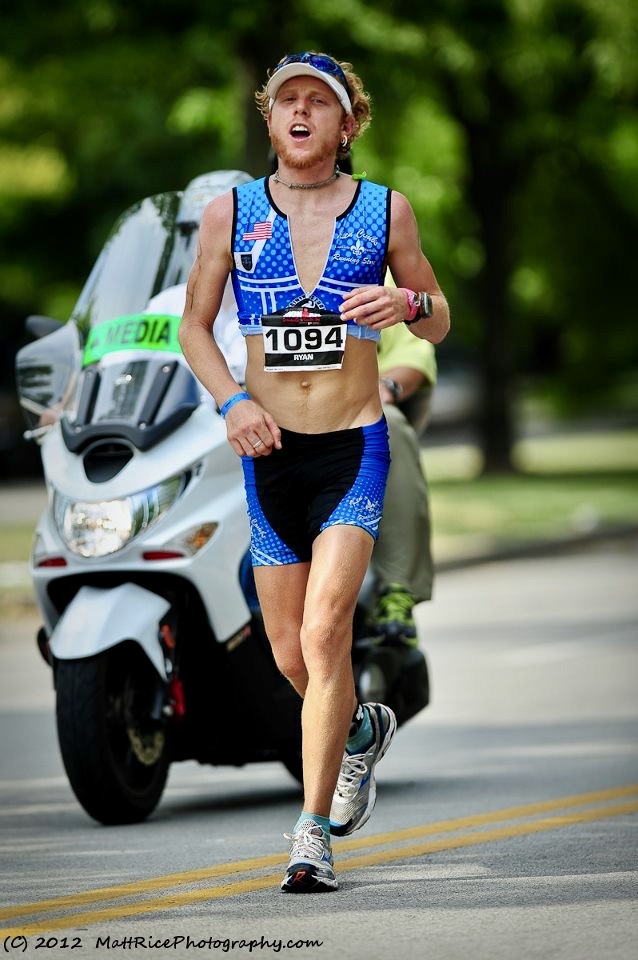Athleticism, anorexia and addiction: endurance for eating disorder recovery

Athleticism, anorexia and addiction: endurance for eating disorder recovery
It’s a common nightmare; one you may experience upon reviewing your physical training and racing schedule….
You’re in a race or being chased — swimming from a big fish, fleeing from a big bear or sprinting towards a big finish. You know how to run, remember what it feels like to run, and sure as hell want to run, swim, jump or leap … but you’re not getting anywhere. Your legs are too heavy, your arms won’t pull you through the water and your bike tires are glued to the asphalt. You’re sinking in quicksand or getting pulled away from dry land — and the harder you try, the more fearful and frustrated you become as you feebly fight for a far-off finish or flee from the ferocious feline gaining on you from behind. Then, just when you’re about to give up or get eaten, something magical happens. You wake up.
I awoke from that nightmare one morning recently; however, it was not the obnoxiously familiar buzz of my clock that called me to consciousness, it was the warning alarm of the EKG (electrocardiogram) machine, alerting the nursing staff that my heart-rate had dropped, again, to a dangerous level. I squirmed my way free from the sterilized sheets and set my feet on the cold tile floor, but something was very wrong — true, I’d awoken from my slumber, but not my nightmare.
I stood, but my atrophied legs struggled to support the weight of my body and my feet felt like they were still sinking in quicksand. I knew how to run, I remembered what it felt like to be fast, and, lord knows, I wanted to flee from that intensive care room I had wakened in; however, my body was weak and wired to machines and intravenous (IV) tubes. I was stuck in a very bad, but very real, disordered dream.
Question: How does one go from elite athlete to emaciated person with anorexia?
Answer: By allowing their addiction to steal what was once a source of enjoyment and by allowing their lack of self-care and acceptance to impact their endurance.
Rewind:
My eating disorder and exercise addiction are nothing new — I’d lived with them for decades despite a period as a professional marathoner, an elite Ironman triathlete and an endurance athletic coach. True, I was skinny, but I managed to stay strong. I was driven, albeit secretly disordered. I was fast but, undeniably, underfed. My successful athletic career was slowly slipping.
Ever since winning my first race as a high school freshman, I had lived life in pursuit of a faster mile split, a steeper mountain and a victorious finish; little did I realize that these ego-driven endorphin fixes were feeding ED (the personification of my eating disorder, not an abbreviation for erectile dysfunction, as it is commonly mistaken) And, as I began to fall short of the self-imposed list of evolving goals, ED eventually convinced me to stop feeding myself.
In response, I ended up retiring from the endurance athletic world in 2015, after heat exhaustion left me crawling (instead of my trademark cartwheel) across the finish-line of the Louisville Ironman with a broken heart, bruised ego and beaten body. In all honesty, I had been on a downward spiral for years, following a severe hamstring tear in the 13th mile of the Boston Marathon, but my addiction to training and exercise kept me from recovery. Thus, what was far from a career ending event led to a series of overuse injuries and depressive decline.
ED has a convincing way of overriding common sense
Had I rested and nourished my body I would have been back on the trails within a few months. However, rest and nourishment have never been my forte, and the guilt-rooted anxiety that came with stillness caused me to seek creative ways to burn off calories that I had already cut from my diet upon being sidelined. Needless to say, it doesn’t take a nutritional degree or coaching credential to recognize that forgoing fuel while upping one’s energy expenditure is an unbalanced equation; however, ED has a convincing way of overriding common sense.
Exercise, or athletically induced anorexia is incredibly common in the endurance sports community and its roots go much deeper than one’s reflection in a mirror or the numbers on a scale. For athletes, it is anorexia is both a behavioral and substance addiction (and a deadly one at that) tied to our pursuit of an ever-elusive runner’s high and the drug we know as dopamine. Whether you get your fix in the water, on the trail, atop a mountain, or soaring thru the sky — the endorphins- added euphoria is universal. However, as we hike, run, and climb our way through life, I encourage all of us to pause and reflect on why we do what we do.
I had to remember what got me into sport in the first place
I managed to crawl my way out of the Intensive Care Unit (ICU) and free myself from the quicksand, but not without a few rounds of residential care that required more emotional endurance than any ironman event I’d competed in. That said, I am far from in the clear because, unlike a drug or alcohol addiction, someone struggling with an eating or exercise disorder must face their drug of choice multiple times every day. In other words, I couldn’t go cold turkey on food or movement…and I wouldn’t want to because, when balanced, each meal provides a source of pleasure. However, to compete at my full potential and fully enjoy my athletic pursuits, I had to remember what got me into sport in the first place.
In the exercise addiction recovery community, talk often centers on the difference between mindful and mindless movement. That term, recovery, carries two distinct connotations: there is recovery from a hard workout, injury, or race and recovery from a disorder or addiction — and both require intention, self-awareness, and self- acceptance (things that many of us struggle with.) As alluded earlier, I lived most my life striving to prove myself via finishing times, adventurous social media pics, and exercise measuring tools such as strava stats.
Proving myself often entailed punishing myself
However, proving myself often entailed punishing myself — and at the end of the day, the only one that actually cared was me. When I had a bad race or workout, I’d restrict my calories and train harder the next day instead of resting and refueling my body, and when I’d wake up injured, I’d load up on IBProphin (a type of anti-inflammatory pain reliever) instead of listen to my body’s cries that it was overworked. Thus, anxiety and a lack of self-acceptance slowly transformed my training into what we call ‘mindless movement’ and, as a result, once pleasurable athletic pursuits became forms of self- punishment.
The first supervised workout that I was allowed to partake in during residential treatment was a ‘mindful movement’ class that could best be described as yoga on tranquilizers.
“What do you feel?” the instructor asked while we gently lifted our arms above our heads into mountain pose and then bent forward to touch out toes.
Though I originally mocked her, referring to our activity as exercise, her question called me to re-connect with my body and re-evaluate my personal state of fitness (or lack thereof.) My stiff hamstrings shouted at me as they struggled with the simple movement and my head spun as the blood rushed out of it upon straightening (a condition known as orthostasis).
I had to stop using activity as a means of fleeing from my feelings
This was the first time in a long time that I had focused on what I was actively feeling, instead of using activity as a means of fleeing from my feelings and, despite the ease of the workout, my body was telling me that it was sore and strained.
I’d spent over a decade working out four to eight hours a day — whether in a prescribed brick workout during triathlon season or anxiety-induced aerobic session — all in an attempt to mute the messages of my body; however, this adventure in recovery was teaching me that exercise isn’t supposed to break us down or mask our feelings but build us up and make us feel better.
Just the same, a race isn’t about our finishing time as much as the opportunity it provides to connect with like-minded friends. Mindful movement is thus an adventure of the body, mind, and spirit that allows us to connect with our true self and community, not to escape ourselves.
If you are in an ED nightmare, reach out for help
So, take time to meditate on the magic of your chosen source of sport and ways you can nurture your mind, body, and spirit through mindful movement instead of numbing your emotions, aches, and pains by mindlessly forcing it. Furthermore, many of us struggle to find balance when it comes to nutrition and exercise (whether we over or under indulge), so, if in need of support, don’t hesitate to seek it!
Eating disorders are the deadliest mental illness. They are not you, rather they are sicknesses to be treated, not ashamed of. I was lucky to waken from my nightmare and there are plenty of resources out there, readily available to make sure you can awaken from your nightmare, too.






Thank you for bravely sharing your healing process, Ryan! I love what you said about connecting with your body / feelings through mindful movement instead of disconnecting from feelings through intense, repetitive exercise. I wish you the best in your recovery.
Thanks Jen! Sharing my story was much more pleasant an experience than holding it in… Take a look at my recent book, ‘From emaciated to emancipated’, for the full story!